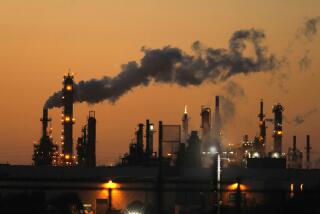Carson Concludes It Can’t Control Refinery Expansion
- Share via
Despite protests by dozens of angry residents Tuesday night, the Carson City Council reluctantly concluded that it has little chance of controlling a controversial project at the Fletcher Oil refinery.
Acting on the advice of City Atty. Glenn Watson, the council voted to send a letter to the South Coast Air Quality Management District seeking information about air pollution violations at the refinery and seeking the agency’s support for additional environmental review of the project.
The dispute centers on a $16-million vacuum distillation unit now under construction at the refinery, between Figueroa and Main streets near the Harbor Freeway. The unit, which will produce a heavy oil used to manufacture asphalt, was approved by the city 11 years ago as part of a larger expansion project but was never built.
More Pollution Feared
Neighbors, who have packed three City Council meetings, complain that the unit will add pollution in an area already burdened with odors from nearby sewage treatment and fertilizer plants. They say they should have been informed when the project received its most recent approval from the South Coast Air Quality Management District last fall.
“Why do we, the residents and homeowners, continually have to be watchdogs against City Hall?” demanded Barbara Post, the spokeswoman for opponents of the project.
The Carson City Council, for its part, has been advised by the city attorney that it lacks legal leverage. Watson told the council that the city might have to pay for a new environmental impact report itself, and even then it would almost certainly have no legal basis to insist on any recommended modifications.
Such a report would be “just reading material,” Watson said. He advised the council to lobby board members of other government agencies for their support.
Refinery officials contend that the unit will actually improve air quality because the AQMD is requiring stringent pollution controls that other refineries won’t have to satisfy until 1994. The officials expressed bewilderment at the ruckus the project has stirred.
“We aren’t really sure why people are so aroused about this,” said Fletcher President Mark Neugard.
But surrounding the particulars of the Fletcher project is the sense among council members and neighbors that the area near Fletcher in southwest Carson has borne the brunt of recent expansions of the nearby county Sanitation Districts’ mammoth sewage treatment plant and the Kellogg Supply Inc. fertilizer plant.
Cumulative Impact
Councilwoman Sylvia Muise asked whether the cumulative impact of the expansions could be considered a reason to trigger a new review of Fletcher or the county sewage plant.
Watson said the city cannot require such a review, but he suggested that council members approach the air quality board, which has broader environmental oversight powers.
In separate interviews, officials for the refinery and the sewage and fertilizer plants said air emissions from their operations have declined over the last several years.
Sewage officials said the treatment plant’s emissions of carbon monoxide and oxides of nitrogen and sulfur today are only 19% of what they were in 1980. However, they acknowledge that the emissions are expected to double from their current level when a $150-million waste-to-energy project is completed in 1990.
A Fletcher spokesman said the refinery’s emissions of the so-called “criteria” pollutants--oxides of sulfur, oxides of nitrogen, carbon monoxide, reactive organic gases and particulate matter--have steadily declined in the last five years and now are 40% less than they were in 1984.
Operations Cut
Kellogg officials said that, to limit odors, they cut compost operations about 15 years ago from 700 tons of sewage sludge a day to 400 tons. They also say a modernization program several years ago added no pollution.
The main obstacle to council intervention, Watson said, is a conditional-use permit that was approved in 1978 for a two-phase expansion and modernization program at the refinery. Although the first phase was completed several years later, the second phase was postponed and was not resurrected until the refinery changed ownership last year.
Watson said the original permit remains valid because the city code specifies that conditional-use permits are issued on an open-ended basis. The city can require an environmental impact report on a project like Fletcher’s only if the company is applying for a permit, Watson said.
The city attorney held out a slim hope that the validity of Fletcher’s permit could be attacked if Fletcher had violated environmental laws and regulations and failed to correct conditions within 30 days. Watson said he is seeking information on violations from the AQMD.
He added that he is also investigating the possibility that the AQMD failed to satisfy state requirements when it issued permits for the project last fall without making an environmental review.
Short of that, he said, “the city has no legal right to require an environmental impact report.”
FLETCHER OIL REFINERY AIR EMISSIONS
Yearly emission data for Fletcher Oil and Refining Co., in pounds per day.
Year ROG* NOx* SOx* CO* PM10* Total 1984 992 1,112 981 148 290 3,523 1985 685 860 630 115 225 2,515 1986 696 904 723 132 247 2,702 1987 729 860 521 126 225 2,461 1988 663 723 356 110 241 2,093
* ROG: reactive organic gases. NOx: oxides of nitrogen. SOx: oxides of sulfur. PM10: particulate matter less than 10 microns in diameter.
SOURCE: Fletcher Oil
More to Read
Sign up for Essential California
The most important California stories and recommendations in your inbox every morning.
You may occasionally receive promotional content from the Los Angeles Times.










